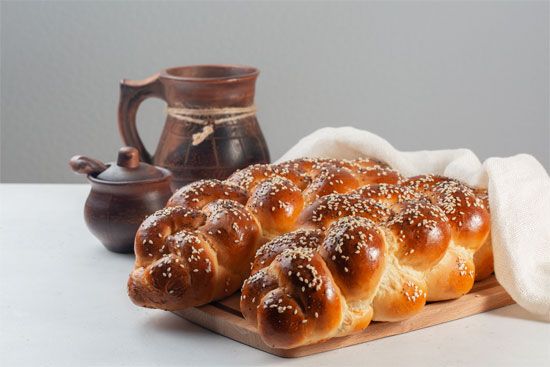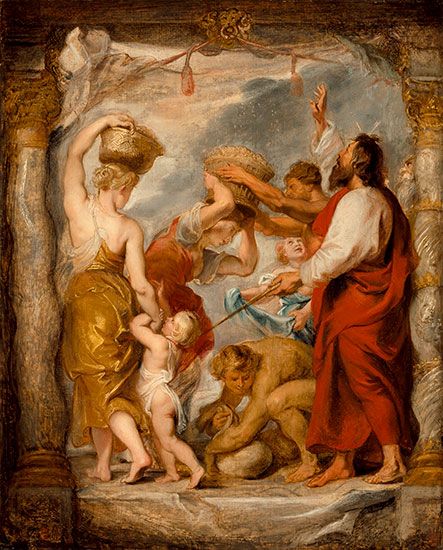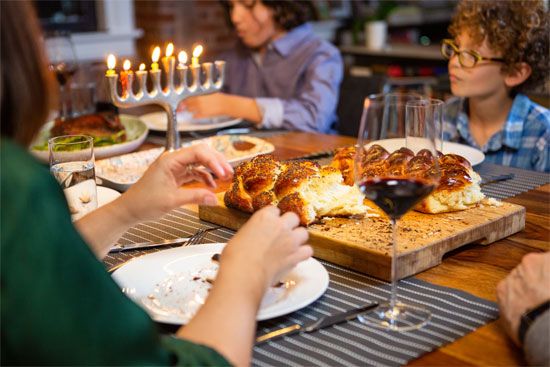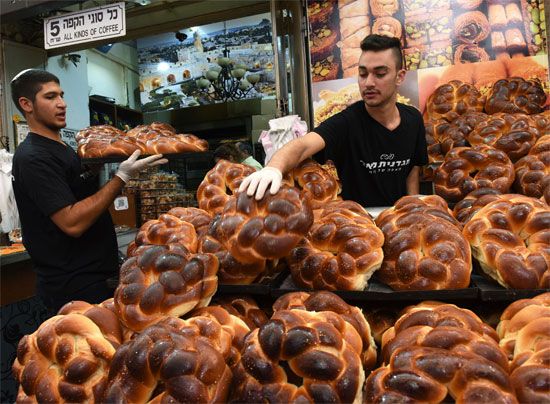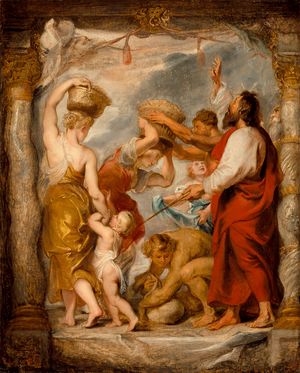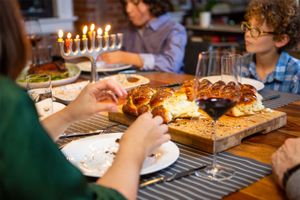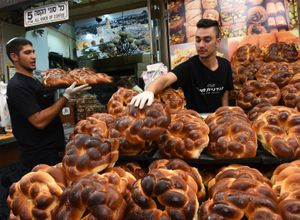challah
What is challah?
How is challah traditionally served during the Sabbath?
What is the significance of the braided form of challah?
What is the ritual of “taking challah”?
challah, traditional Jewish yeast-leavened bread that is made with eggs and is known for its rich flavor. Challah is usually braided and is served on the Sabbath (Shabbat), the day of holiness and rest observed by Jews from sunset on Friday to nightfall of the following day. It is also served on certain holy days such as Rosh Hashana, a two-day celebration that inaugurates the Jewish New Year.
Origins of challah
Classic challah is made from flour, yeast, eggs, oil, and a sweetener, such as sugar or honey. The bread can be baked in many different shapes, but most people are familiar with the oval-shaped challah loaf that is braided and then glazed with an egg wash before baking and is perhaps topped with a sprinkling of sesame or poppy seeds or studded with raisins.
The bread originates from the ancient Jewish mitzvah (commandment) found in Numbers 15:17–21 of the Hebrew Bible (Christian Old Testament), spoken by God to Moses. The command instructs the people of Israel to give the first portion of bread dough (the chalah) to the kohen (priest or rabbinical leader) on the Sabbath as a sacrifice.
The braided form evolved in the 15th century from a German and Austrian bread that was served on Sundays and was adapted by Ashkenazi Jews for their Friday Sabbath bread. It was plain in flavor, generally consisting only of flour, yeast, oil, and water. In other countries, such as Poland and Lithuania, Jews used other ingredients that were available to them, such as saffron, which gave the bread a yellow tinge.
Sugar was not a common ingredient of challah bread until the 19th century in the United States, when it started to become more affordable. Similarly, eggs were typically only used for glazing (which gives the challah its beautiful burnished finish). Many other common elements of classic challah bread, such as seeds, were later embellishments as these ingredients became more widely available.
Challah days
Challah is integral to the Jewish observance of the Sabbath. On Friday evening, as the Sabbath begins, it is customary to serve two loaves of challah, which commemorates the double portion of manna (“bread from heaven”) that was miraculously provided by God so that the Israelites would not be compelled to gather food on the Sabbath during their 40 years of wandering in the wilderness. The loaves are covered with a challah cover or white napkin, which represents the dew that collected on the manna each morning.
After reciting the Kiddush, a blessing of sanctification said over the wine, the challah itself is blessed with the Hamotzi, the blessing over bread. The challah is then uncovered and passed around so that each family member can tear off a portion—thereby literally breaking bread. In Let’s Eat: Jewish Food and Faith (2017), authors Lori Stein and Ronald H. Isaacs note that some families believe that cutting or slicing the bread with a knife (a symbol of violence and war) desecrates the challah (a symbol of peace). They also note that salt is sometimes sprinkled on the bread, commemorating ancient sacrifices in the Temple of Jerusalem.
The braid also has symbolic meaning, although this depends on the baker’s technique and the size of the bread. Generally, however, the strands of braided dough may symbolize the intertwining of important values, such as love, unity, peace, justice, and family. The 12 “bumps” of the braid represent the 12 loaves of bread that stood for the 12 tribes of Israel, presented and shown in the Temple (Leviticus 24:5). For the Sabbath the two challah loaves often each have three-stranded braids, which together represent the harmony of the six days preceding the Sabbath.
For Rosh Hashana challah is typically baked in the shape of a circle, which represents the eternal life cycle. For Yom Kippur, a solemn holiday of repentance for sins and reconciliation with God, the challah may be round or made in a ladder shape, which symbolizes the ascension to heaven. Loaves shaped like hands are also common for Yom Kippur, representing a good year to come. During Shavuot a pair of oval loaves placed side by side call to mind the tablets of the Ten Commandments. In some places small triangular challah loaves are eaten for Purim to symbolize the ears of wicked Haman, who sought the annihilation of the Jewish people (see also Esther).
A Greek Orthodox version of challah bread is sometimes served at Easter, the Christian celebration of the resurrection of Jesus Christ. The Greek tsoureki, a sweet loaf- or round-shaped bread, is braided using three strands of dough, which symbolizes the Trinity. The bread is baked with red-colored hard-boiled eggs in the shell woven into the braid. The eggs symbolize new life and the color red symbolizes the blood of Jesus Christ.
Taking challah
When a large batch of challah is made it is customary to perform a ritual known as “taking” or “separating” challah in commemoration of the offering that was made to priests of the Temple of Jerusalem in ancient Israel. After the dough is kneaded and left to rise, but before it is baked, the baker pinches off a piece of dough about the size of an olive, blesses the piece, and then burns it in the oven. A small batch may not require the step of taking challah.
Most people do not make large batches of challah at home anymore, so kosher bakers typically take challah from their loaves and designate on the bread wrapper that “Challah has been taken.” However, if challah has not been taken or if it is unclear whether this has been done, a small piece of the loaf can be broken off and burned before serving to satisfy this requirement.
Making the braid
Challah bread is braided after the dough has been mixed and set aside to rise for the first time. The dough is turned out on a lightly floured work surface and divided into an equal number of pieces depending on how many strands the baker uses for the braid. The six-strand challah is the standard braid, but there are braids using three, five, or eight, or other numbers of strands.
Either way, the pieces of dough are shaped into ropes and then placed perpendicular to the baker side by side to each other, so that the baker is looking at a series of long parallel lines of dough. The baker then pinches the strands together at the top end and arranges the strands at the bottom end so that they are slightly spread out like a fan. The baker then typically begins braiding by taking the outermost right strand and crossing it over or under the outermost left strand, gradually weaving the strands together until the baker reaches the bottom end.
This braiding takes practice but is an essential part of the art of challah making. After the braid is complete, the loaf is brushed with egg wash and set aside to rise a second time, then brushed with egg wash again. Finally, the challah is placed in the oven for baking.
Modern challah
Many Jewish bakers and lovers of Jewish food have found creative uses for leftover challah bread. With its rich, sweet dough, challah makes for a delicious French toast or bread pudding. Leftover challah can also be used to make croutons. Inventive bakers and cooks have used challah dough to make hot dogs buns, onion rolls, grilled cheese sandwiches, croque monsieur, shortcakes, and pane cotto.
Some bakers make stuffed challah bread, in which a filling, such as pesto or goat cheese, is spread onto a flattened layer of dough before rolling it into a rope or onto the ropes of dough before braiding them. In addition bakers may experiment with the classic challah recipe, adding herbs and spices such as rosemary, fennel, or cinnamon to the dough. Sephardic challah, for example, is often seasoned with coriander, cumin, or anise.

